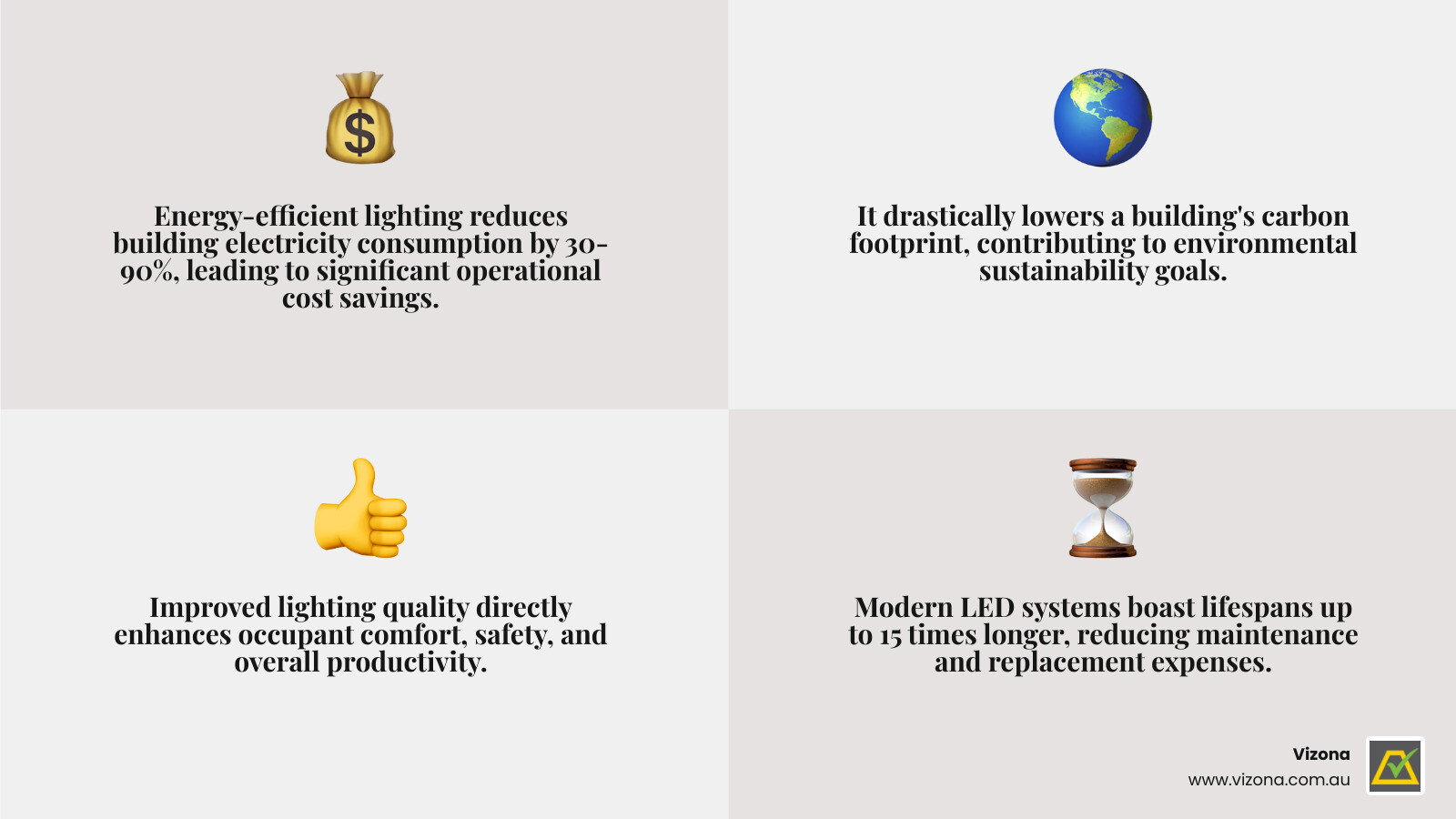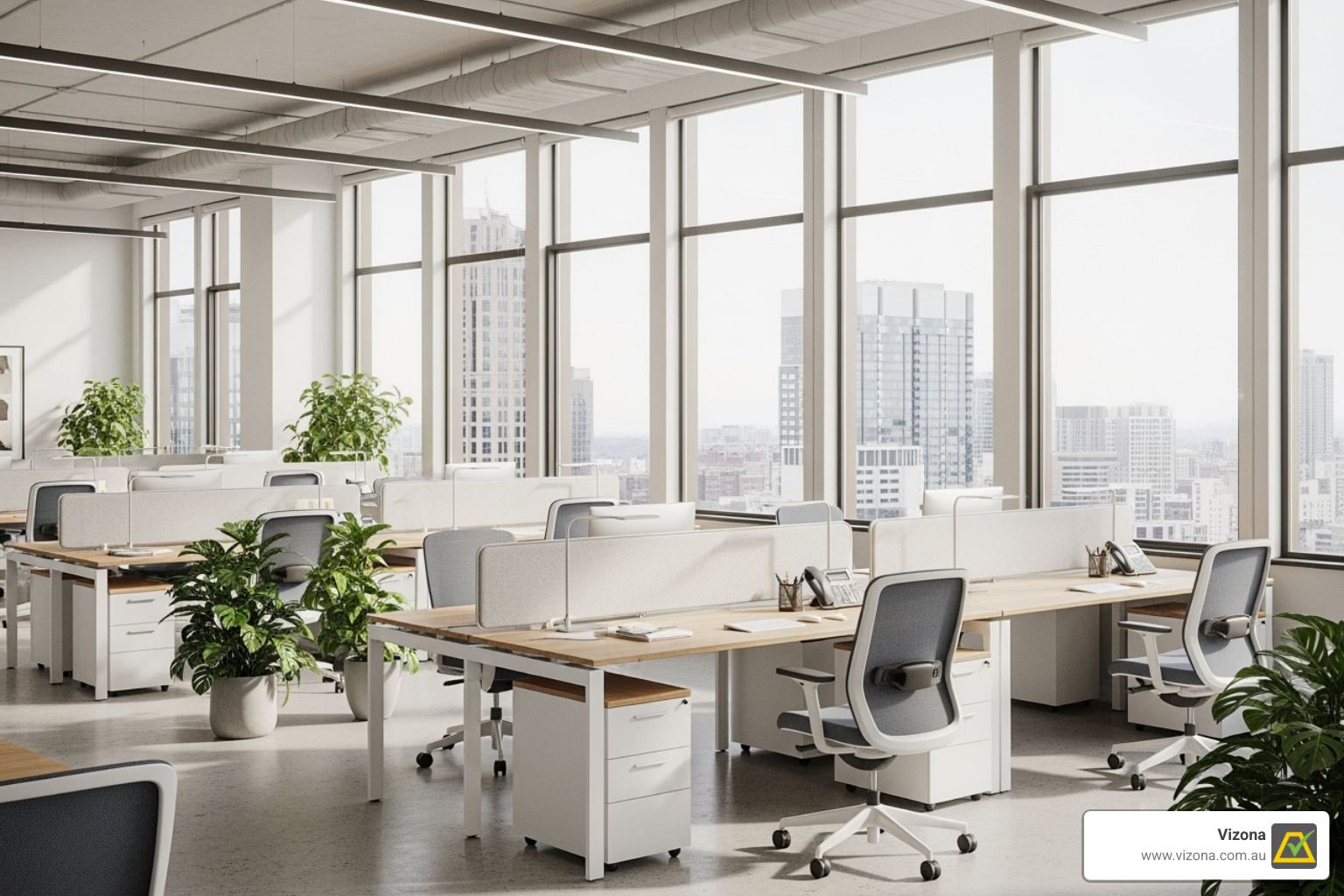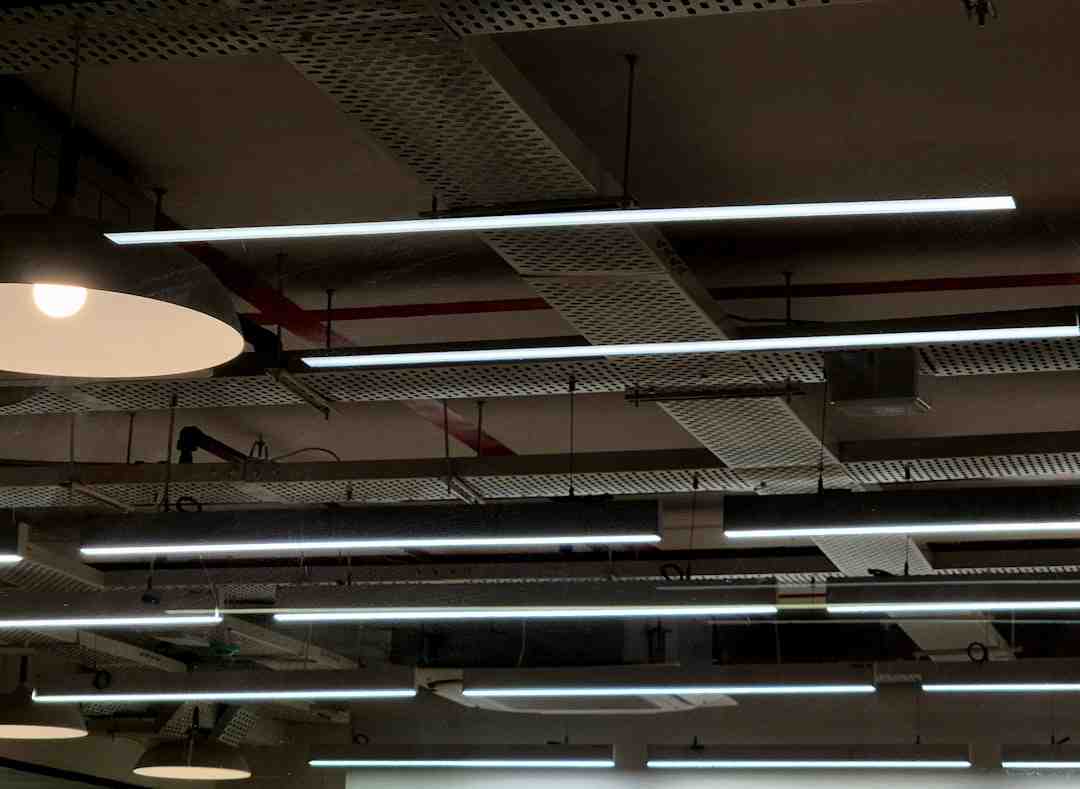Why Energy-Efficient Lighting Design Matters for Urban Spaces
Lighting shapes how we experience our cities, and when designed efficiently, it can do much more than illuminate. Energy-efficient systems reduce costs, lower carbon footprints, enhance safety, and help cities adapt for the future. But knowing the benefits is just the start. Implementing a smart, effective system requires a clear plan.
Quick Answer: Core Steps for Energy-Efficient Urban Lighting Design
- Audit Existing Systems – Identify where public lighting consumes the most energy.
- Choose LED Technology – Replace outdated systems with high-efficiency LEDs.
- Implement Smart Controls – Use sensors, timers, and dimmers to automate savings.
- Optimise Lighting Layouts – Direct light only where needed to improve safety and reduce waste.
- Analyse Total Cost of Ownership – Factor in rebates, reduced maintenance, and long-term energy savings.
Lighting shapes how public spaces function and how people experience them. While poor lighting drains municipal budgets and creates unsafe environments, good lighting cuts costs, supports sustainability goals, and creates safer, more vibrant communities.
In the public realm, street lighting alone can account for up to 40% of a council's electricity budget. The opportunity for savings is immense. LED lighting uses up to 90% less energy than traditional technologies and lasts significantly longer, drastically reducing maintenance costs. Widespread LED adoption can save councils millions annually and significantly reduce national electricity consumption.
This guide walks through the essential steps for designing lighting systems that deliver measurable savings and better public spaces.
I'm Gavin Cook, Managing Director of Vizona. For over 20 years, I've specialised in energy efficient lighting system design for building and public infrastructure projects across Australia. At Vizona, we help clients transform their lighting with sustainable materials, innovative LED technology, and smart controls. This guide provides a framework for making informed, cost-effective decisions that deliver long-term value.

A Blueprint for Energy-Efficient Urban Lighting Design
Designing an energy-efficient lighting system for urban spaces involves understanding its benefits, choosing the right technologies, applying smart design principles, and making sound financial decisions.
Why Prioritise Energy-Efficient Lighting?
An energy-efficient lighting system is a strategic investment that offers a cascade of benefits beyond lower electricity bills for councils and property managers.
Financial Benefits
Upgrading public lighting can cut operational costs by 30% to 60%.
- Lower Electricity Bills: LEDs use significantly less energy than older technologies like HID lamps.
- Reduced Maintenance: LEDs last much longer, cutting replacement and labour costs associated with servicing public infrastructure.
- Enhanced Public Amenity and Value: Modern, efficient lighting makes public spaces more attractive, encouraging community use and attracting investment.
Environmental Responsibility
Efficient lighting reduces carbon emissions and demand on power grids.
- Reduced Carbon Footprint: Lower energy use directly reduces greenhouse gas emissions.
- Achieve Sustainability Goals: Align with green initiatives and council sustainability targets.
- Less Waste: The long lifespan of LED products means less material heading to landfill.
Benefits for Community and Public Safety
Quality lighting has a profound impact on how communities interact with their environment.
- Enhanced Public Safety: Well-lit streets, parks, and pathways help deter crime and reduce accidents.
- Improved Community Well-being: Good lighting encourages the evening use of public spaces, fostering community interaction and local economic activity.
- Reduced Light Pollution: Modern, directed luminaires minimise skyglow, preserving night skies and protecting nocturnal wildlife.
Since public lighting can consume a large portion of a municipality's electricity budget, the potential savings are immense. For more on how energy efficiency can benefit your operations, explore our insights on Reduced Energy Consumption.
Choosing the Right Lighting Technology
Modern energy-efficient design for urban spaces overwhelmingly favours Light Emitting Diodes (LEDs) over older technologies.
Key Outdoor Lighting Technologies
- LEDs (Light Emitting Diodes): The undisputed champion of energy efficiency. LEDs use up to 90% less energy than traditional bulbs and can last 40,000 to 100,000 hours. Their low heat output, durability, and excellent light control make them ideal for all outdoor applications.
- HID (High-Intensity Discharge) Lamps: Previously common for large outdoor areas like car parks and stadiums. HIDs are relatively efficient but suffer from long start-up times, poor colour rendering, and are not well-suited for smart controls.
- Fluorescent Lamps: More efficient than incandescent lamps but are being superseded by LEDs due to their shorter lifespan, temperature sensitivity, and environmental concerns (mercury content).
- Induction Lamps: Known for very long lifespans, but their higher cost and lower efficiency compared to modern LEDs have made them a niche choice.
- Incandescent Lamps: Highly inefficient and fragile, converting most energy to heat. They are not used in modern public lighting projects.
For a deeper dive into LED technology, the U.S. Department of Energy (DOE) offers an excellent overview on LED lighting. Explore our solutions on our LED Lighting Solutions page.
Core Principles for Effective Urban Lighting Design
Effective energy efficient lighting system design for building better urban spaces creates environments that are safe, comfortable, and energy-conscious.

Strategic Design for Safety and Reduced Light Pollution
Effective design ensures light is a tool, not a nuisance. This involves directing light precisely where it is needed (e.g., on a pathway, not into the sky or nearby windows) and using the appropriate brightness level for the task. This approach, known as using proper cut-off optics, enhances safety while minimising energy waste and light pollution.
Layered Lighting Strategy for Urban Spaces
Modern urban design employs a layered approach to meet diverse needs:
- Ambient Lighting: Provides general, overall illumination for safety and navigation, such as street lighting.
- Task Lighting: Delivers focused light for specific activities, like lighting on pathways, benches, or public transport stops.
- Accent Lighting: Highlights architectural features, public art, or landscaping to add visual interest and create a sense of place.
Matching Light to Function and Space
The amount and quality of light should match the function of the space. A busy public plaza requires different lighting than a quiet residential street or a park pathway. Design must consider the specific visual tasks and desired atmosphere for each area.
Our approach to Sustainable Lighting Design emphasises these principles. For guidance on urban spaces, see our Urban Lighting Solutions Ultimate Guide.
The Role of Smart Controls in Maximising Efficiency
Smart controls act as the brain of a lighting system, ensuring energy is never wasted.
Types of Smart Controls
- Occupancy Sensors: Automatically turn lights on or dim them based on the presence of pedestrians or vehicles. They are ideal for parks, pathways, and car parks.
- Daylight Sensors (Photosensors): Measure ambient natural light and automatically turn artificial lights on at dusk and off at dawn, or dim them during twilight hours.
- Timers and Schedules: Ensure lights operate only during scheduled hours, perfect for sports fields or public facilities with set operating times.
- Dimmers: Allow for scheduled reductions in light levels during low-traffic periods, such as late at night, saving significant energy.
- Networked Lighting Control Systems: Integrate all controls into a single, intelligent system for central management, fault monitoring, and data analytics.
Internet of Things (IoT) Integration
IoT connects luminaires and sensors to the internet, enabling advanced automation. This allows for real-time data collection, adaptive controls that respond to weather or events, and integration with broader smart city platforms.
Explore how smart solutions are shaping urban environments in our Smart Outdoor Lighting Ultimate Guide.
Financial Blueprint: Costs, Savings, and Incentives
While an energy-efficient lighting system involves an initial investment, the long-term financial returns are compelling.
Initial Costs vs. Operational Savings
Modern LED fixtures and controls have a higher upfront cost but are quickly offset by major reductions in electricity consumption and dramatically lower maintenance expenses over their long lifespan.
Calculating Return on Investment (ROI)
A thorough financial analysis calculates ROI by comparing the total project cost against the annual energy savings, reduced maintenance costs, and any available rebates or incentives.
Total Cost of Ownership (TCO)
TCO considers all costs over a system's lifespan, including purchase, installation, energy, and maintenance. Due to their longevity and low energy use, LED systems consistently demonstrate a far lower TCO than traditional lighting.
Rebates and Incentives
Many governments and utilities offer rebates, tax credits, and grants that can significantly reduce the initial investment. For information on available incentives, visit the Energy Star® Program website.
How to Implement Your Energy-Efficient Lighting System
A structured approach makes any lighting upgrade manageable.
Getting Started: Professional Consultation
For commercial and public projects, engaging professionals is essential. They can conduct lighting audits, create compliant designs and simulations, manage rebate applications, and ensure proper installation.
For complex projects, finding a Certified Lighting Professional is a crucial step. Our Commercial LED Lighting Australia insights also offer guidance.
Phased Implementation
Large-scale projects, like a city-wide street lighting upgrade, can be implemented in phases to manage budgets and minimise disruption. Prioritise areas with the highest energy use or oldest technology first.
Simple Steps to Get Started
- Assess Current Lighting and Energy Use: Understand your baseline consumption.
- Identify Priority Areas for Upgrade: Focus on spaces with long operating hours or outdated technology.
- Research LED and Smart Control Options: Familiarise yourself with the latest technologies.
- Consult with a Certified Lighting Professional: Get expert advice for your specific project.
- Plan Phased Upgrades and Monitor Results: Implement changes strategically and track your savings.
Build a Smarter, More Sustainable Urban Space with Vizona
The journey towards an optimised energy efficient lighting system design for building better communities is a strategic investment that yields significant returns. We've seen how it delivers substantial cost savings, contributes to environmental sustainability, and dramatically improves the experience for the public.
At Vizona, we are proud to be an Australian manufacturer and wholesaler, providing high-quality, sustainable solutions built for our local conditions. Our commitment to using recyclable materials like aluminium and innovative LED technology ensures that our solutions are not only efficient but also environmentally responsible and durable.
Whether you're looking to design a new system from the ground up or upgrade an existing one, our team of experts is here to guide you. We offer comprehensive lighting design services, ensuring your project meets both performance and compliance standards.
- Explore our custom lighting design services and see how we can bring your vision to light: Explore our lighting design services
- Browse our range of high-performance commercial and sports LED lighting products, engineered for efficiency and longevity: Browse our commercial LED lighting products
- Find our sustainable solar lighting solutions, offering off-grid reliability and minimal environmental impact: Discover our sustainable solar lighting solutions
Partner with Vizona to create lighting systems that are smart, sustainable, and built to last.
Contact Us Today: Phone: 1300 250 150 Email: info@vizona.com.au

